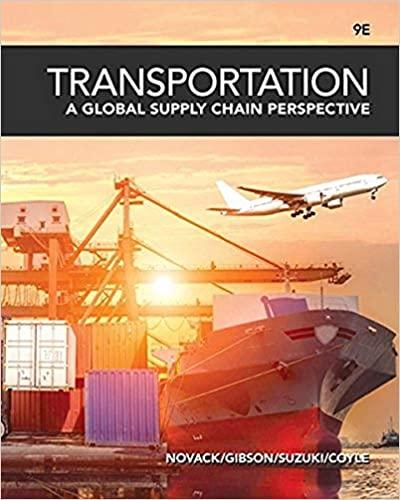Oil production in the Bakken Region of the United States and southern Canada has increased rapidly over
Question:
Oil production in the Bakken Region of the United States and southern Canada has increased rapidly over the last few years because of the world price for oil. In North Dakota alone, from July 2012 to July 2017, barrels per day rose 54.9 percent from 20,969,942 to 32,473,306. During the same time period, the number of wells producing rose 86.7 percent from 7,309 to 13,648.
This rising production required increases in transportation capacity to move the oil to markets. While pipeline is the traditional mode of choice to move oil, its infrastructure was inadequate to move the product to markets on the East Coast of the United States and to refineries in Texas and Louisiana. To fill this transportation need, rail carriers, such as the Canadian National, Canadian Pacific, and the BNSF, increased railcar movements of oil to both the East Coast and Southwest. Because of the volatile nature of the oil being produced in the Bakken Region, rail movements can pose a safety hazard during transit and several derailments of these cars caused severe damage and environmental concerns.
The Keystone XL Pipeline was proposed by TransCanada to increase capacity to move oil from southern Canada and the Dakotas. Starting in Alberta, Canada, the Keystone would travel 1,179 miles south to the junction of Steele City, Nebraska. From there, oil could be moved east to the Wood River Refinery in Roxana, Illinois, and south to refineries in Port Arthur and Houston, Texas.
The State Department raised concerns about the construction because of its possible negative effects on the fragile ecosystem in the Sandhills Region of Nebraska. Environmentalists raised concerns over the increased energy needed to extract the oil from the tar sands, which would add to global warming and the possible chemical leakage into groundwater. However, environmentalists are also concerned with the negative impact to public safety of transporting the oil by rail. The U.S. government has vowed to invest $1 trillion over the next 10 years in U.S. infrastructure. Although this investment is typically made in public projects (such as highways and bridges), there is an opportunity to also subsidize the construction of pipelines and rail trackage, which are privately owned. With the growing production of domestic oil and natural gas, the need for increased capacity in transportation infrastructure is evident.
QUESTIONS
1. Given the importance of domestically produced oil to the U.S. economy, should the U.S. government promote and subsidize the construction of pipeline and/or rail infrastructure? Explain your answer.
2. Discuss the advantages and disadvantages of increasing capacity to move this oil by pipeline and by rail. Be sure to include in your discussion environmental, safety, and economic impacts of using each mode.
3. If you had the authority as a U.S. government official, which mode would you choose and why?
Step by Step Answer:

Transportation A Global Supply Chain Perspective
ISBN: 9781337406642
9th Edition
Authors: Robert A. Novack, Brian Gibson, Yoshinori Suzuki, John J. Coyle





